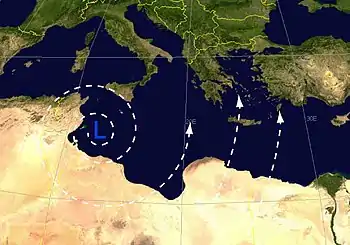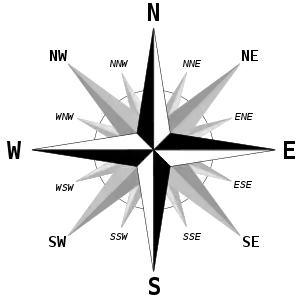Sirocco
Sirocco (/sɪˈrɒkoʊ/), scirocco, jugo or, rarely, siroc (see § Names below) is a Mediterranean wind that comes from the Sahara and can reach hurricane speeds in North Africa and Southern Europe, especially during the summer season.

| The winds of the Mediterranean |
|---|
| Part of a series on |
| Weather |
|---|
 |
|
|
Names
Sirocco is derived from the Arabic word sharqiyya (شرقية) which means 'easterly'. This wind has different names in different languages, including:
- Italian: scirocco
- Sicilian: sciroccu
- Spanish: siroco
- Catalan: xaloc
- Maltese: xlokk
- Occitan: siròc or eisseròc
- Greek: σορόκος, romanized: sorókos, or σιρόκος sirókos
- Albanian: shirok
- Croatian: jugo or rarely širok
- Ligurian: sciöco or mainasso
- Libyan Arabic: قبلي, romanized: ghiblī, which means 'coming from the Qibla', or scarcely qibli
- Egyptian Arabic: خمسين, romanized: khamsīn, which means 'fifty' ('fifty-day wind')
- Tunisian Arabic: شلوق, romanized: chlūq, probably from شروق shurūq with the same meaning as sharqiyya; or شهيلي ch'hīlī
- Moroccan Arabic: شركي, romanized: chergui, also meaning 'easterly'.
Development
It arises from a warm, dry, tropical airmass that is pulled northward by low-pressure cells moving eastward across the Mediterranean Sea, with the wind originating in the Arabian or Sahara deserts.[1] The hotter, drier continental air mixes with the cooler, wetter air of the maritime cyclone, and the counter-clockwise circulation of the low propels the mixed air across the southern coasts of Europe.
Effects
The sirocco causes dusty dry conditions along the northern coast of Africa, storms in the Mediterranean Sea, and cool wet weather in Europe. The sirocco's duration may be as short as half a day or may last several days. While passing over the Mediterranean Sea, the sirocco picks up moisture; this results in rainfall in the southern part of Italy, known locally as "blood rain" due to the red sand mixed with the falling rain.
Sirocco is commonly perceived as causing unease and an irritable mood in people.[2] In addition, many people attribute health problems to the wind, either because of the heat and dust brought from African coastal regions, or because of the cool dampness further north in Europe. The dust within the sirocco winds can cause abrasion in mechanical devices and penetrate buildings.
Sirocco winds with speeds of up to 100 km/h (62 mph; 54 kn) are most common during autumn and spring. They reach a peak in March and in November when it is very hot.
When combined with a rising tide, the sirocco can cause the acqua alta phenomenon in the Venetian Lagoon.
This wind also has an impact on fishing. For example, the anchovies caught in the Gulf of Trieste near Barcola, which are in great demand as a delicacy, are only caught in Sirocco. In cold winds, like the bora, the fish disappears into the vastness of the Adriatic.[3]
References
- Golden Gate Weather Services. Names of Winds. Retrieved on 2006-12-28.
- "Južina značenje, definicija i primjeri". Jezikoslovac (in Croatian). Retrieved 13 July 2020.
- Georges Desrues "Eine Lange Nacht am Meer", In: Triest - Servus Magazin (2020), p 73.
External links
| Wikimedia Commons has media related to Sirocco (wind). |
- Winds of the world
- Local Mediterranean winds
- . Encyclopædia Britannica (11th ed.). 1911.

